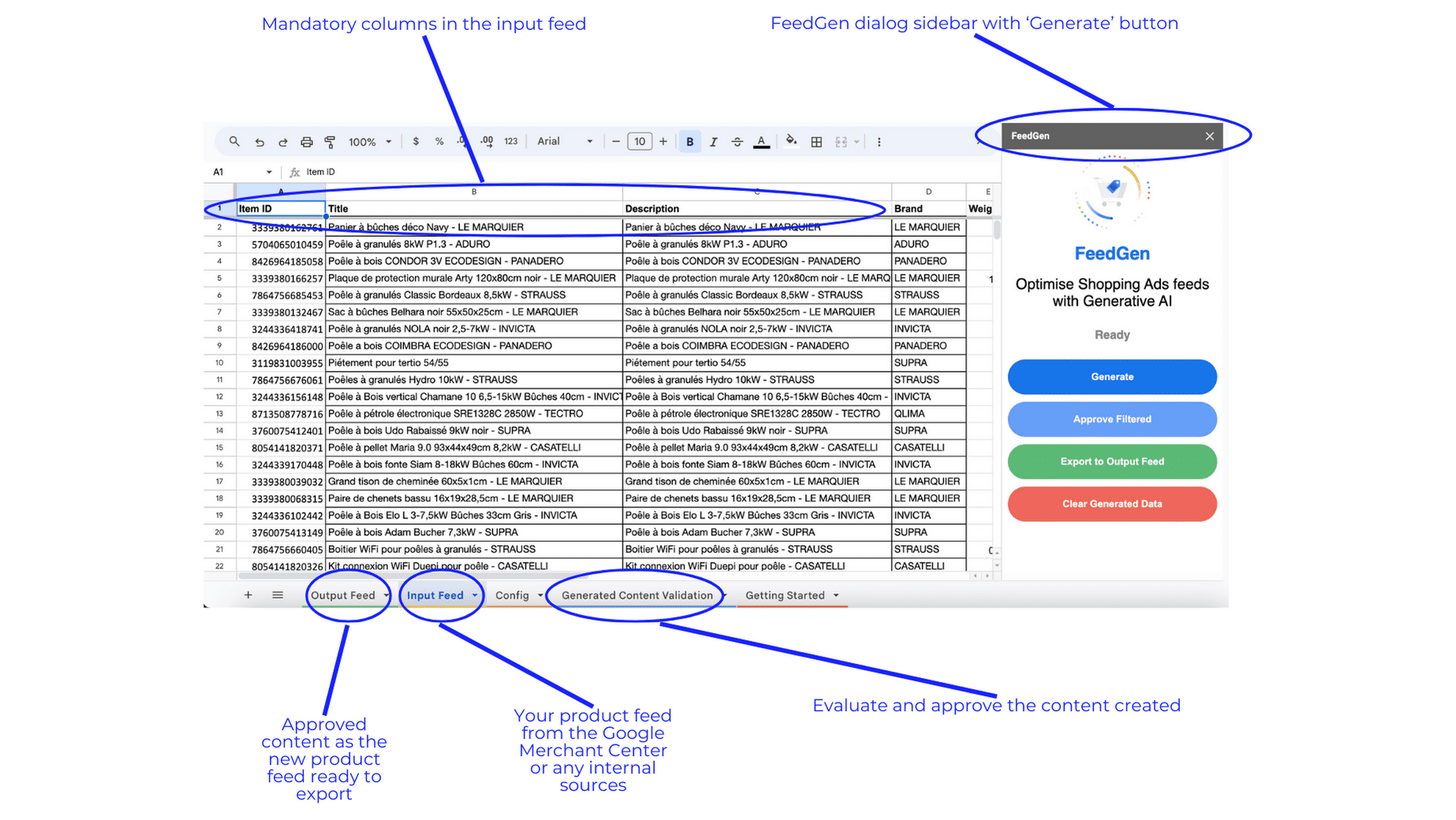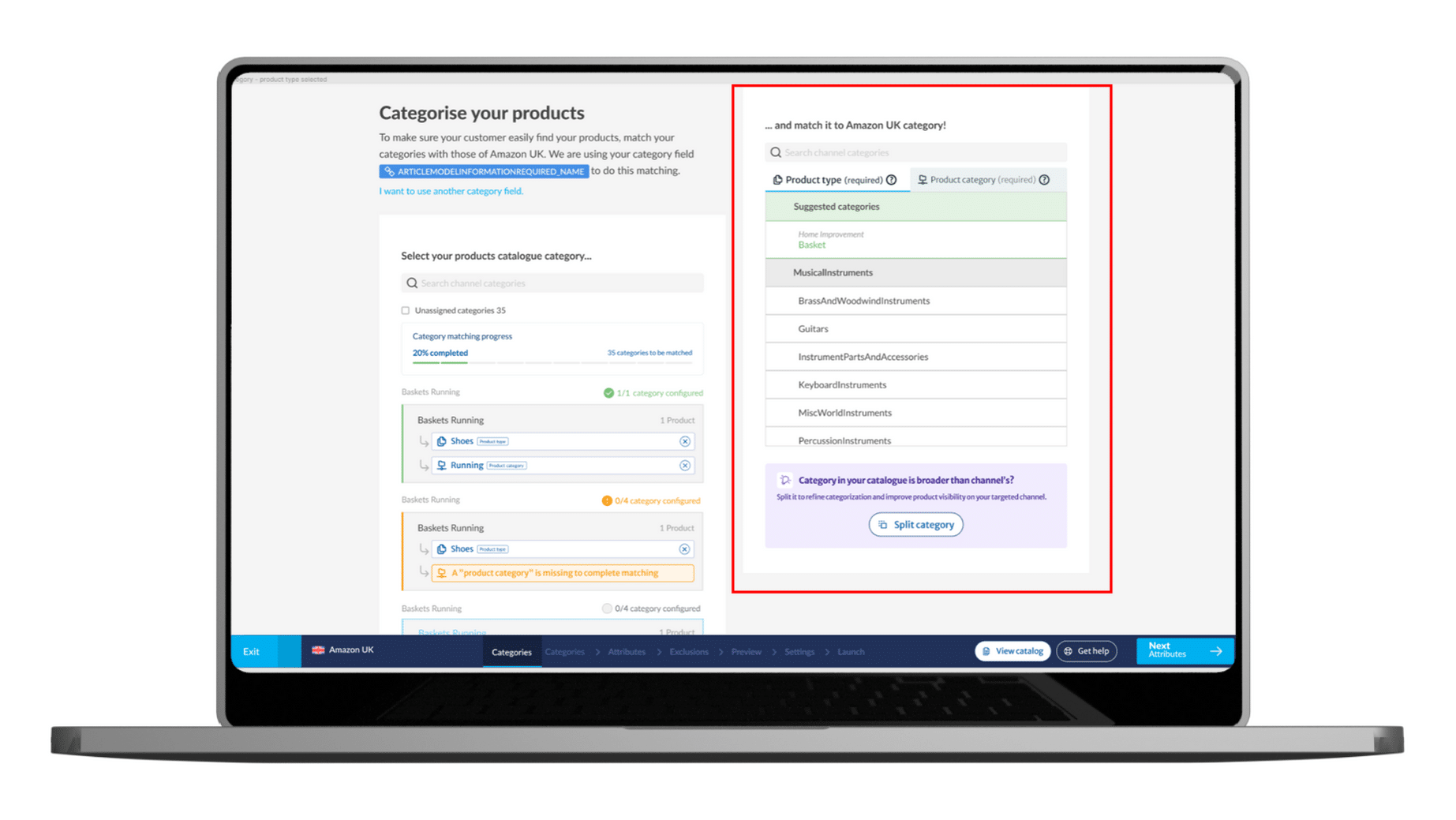How to prepare your e-commerce product feed with AI
13/03/24
7'
It’s no secret that Artificial Intelligence (AI) has a strong impact on e-commerce. From personalization enhancements to fraud prevention, AI has indeed the potential to address a wide range of challenges faced by brands and retailers. This article however aims to demystify the application of AI in optimizing e-commerce beyond the advancements seen in large corporations by exploring how AI offers practical solutions for improving e-commerce product feeds, essential for the success of online merchants.
Specifically, we’ll illustrate how AI can tackle common issues related to e-commerce product feeds, offering tangible examples that demonstrate its capability to streamline operations and increase efficiency with a modest investment. For even more details and insights, download our dedicated guide.
AI in E-Commerce: Product Feed Focus
How to leverage AI to enhance your e-commerce product feed! The corner…
Learn more1/ The easy way: GPT add-ons
The first method: Integrate GPT add-ons into your workflow. Start by installing the “GPT for Sheets and Docs” from the Google Workspace Marketplace. Once installed, activate the GPT features in your spreadsheet by granting the necessary permissions. Keep in mind, this is a paid service, and utilizing your OpenAI API key could provide more favorable pricing options.
Moreover, for those inclined towards customization, Google Apps Script offers the capability to craft custom functions using the OpenAI API. Functions like GPT_SIMPLIFY or GPT_SUMMARY can be created to process text directly from your Sheets, leveraging the power of the OpenAI API to, for example, enhance and summarize your product descriptions seamlessly.
Here are only some practical applications of GPT add-ons for your e-commerce product feed:
- Automated product descriptions: Automate and customize your product descriptions with GPT add-ons in spreadsheets. This ensures your product descriptions are not only rich and detailed but also adapted to the situation. Example: =GPT_SUMMARIZE(“Shorten this description to 200 words max”; B2)
- Content rephrasing: To combat duplicate content, use simple formulas like =GPT(“Rephrase”, B2) to rephrase and refresh product descriptions, maintaining the original intent while ensuring uniqueness.
- Effortless bulk translations: The GPT_TRANSLATE function allows for rapid, bulk translations between languages, simplifying the localization process of your product feed. For example, =GPT_TRANSLATE(A2, “german”, “english”) effortlessly translates text from German to English.
- Analyzing customer reviews: Employ the GPT_CLASSIFY function to categorize customer feedback into distinct categories, such as sentiment or trends. This not only helps in understanding customer perceptions but also in identifying areas for improvement.
2/ The effective way: AI tools
It feels like there are countless AI tools on the market, or tools that pretend to be. It is therefore important to find the right tools for the right tasks – and not to waste time with unnecessary tools. This is especially true when it comes to e-commerce. A brief overview:
Personalized product descriptions: AI-powered tools such as Jasper, Writesonic, or Copy.ai offer a wealth of integrations and features designed to craft individualized and compelling product descriptions that capture the essence of your items.
Enhanced rephrasing capabilities: For content that requires a fresh twist, advanced rephrasing tools like Quillbot AI come in handy, providing specialized functionality for rewriting content. While Jasper, Writesonic, and Copy.ai can also perform rephrasing tasks, Quillbot AI specializes in this area, offering more focused options.
Accurate, bulk translations: Meet the linguistic diversity of your global audience with precision using AI translation tools like Lokalise AI or DeepL Pro (yes, the Pro version!). These tools are specifically engineered for translating content in bulk without sacrificing accuracy, ensuring your product feed communicates effectively with customers in different markets.
Automated image resizing: Streamline the visual aspect of your product feed with AI-driven tools like Picsart, which automates image resizing to meet the specifications of various online platforms. Whether you’re adjusting a product photo for an Instagram Reel or standardizing images across your e-commerce site, Picsart can perform these tasks efficiently, demonstrating how AI can swiftly enhance the visual presentation of your products.

3/ The complex way: FeedGen
For e-commerce professionals looking to push the boundaries of product feed enhancement, FeedGen presents a sophisticated solution. Powered by Google Cloud’s Large Language Models (LLMs) within Vertex AI, FeedGen employs novel prompt-tuning techniques to optimize product titles, enrich descriptions, and fill in missing attributes. It stands out by offering a hands-on approach for merchants and advertisers to identify and rectify quality issues in their product feeds through Generative AI, in a manner that’s both simple and customizable.
FeedGen, only available in English for now, operates through a spreadsheet framework. Some key features of it are:
- Description and title generation: Utilizing AI, FeedGen crafts compelling product descriptions and titles. The user-configurable settings ensure the content aligns with your brand voice and product specifics.
- Image understanding: Beyond text, FeedGen analyzes product images, leveraging visual cues to generate more appealing titles and descriptions, particularly beneficial in visually-driven sectors like fashion and home decor.
- Human validation and scoring: To guarantee the content’s quality and relevance, FeedGen incorporates a scoring system, encouraging manual review and validation of the AI-generated titles and descriptions.

Combining FeedGen with Traditional Feed Management Tools?
While FeedGen excels in detail enhancement, it’s not a standalone solution for all feed management needs. For best results, integrate FeedGen’s AI-driven enhancements with traditional feed management tools like Lengow. This hybrid approach ensures your product feed not only benefits from AI-powered optimization but also maintains the structural organization necessary for effective distribution across marketing platforms.
Nota bene: FeedGen, with its complex setup involving Google Cloud Project and Vertex AI API, might pose challenges for those less familiar with AI and machine learning operations.
Go further
4/ The advanced way: Lengow
How to control and adapt your product prices
Dynamic Product Pricing with AI is a game-changer, allowing merchants to fine-tune their product prices based on competitor pricing, production costs, stock availability, and customer demand.
By leveraging AI, such as the capabilities provided by Netrivals, retailers can enjoy dynamic pricing adjustments, optimal pricing settings, and predictive analysis for future pricing strategies. This approach not only saves time but also significantly enhances price optimization for sellers with extensive product ranges. The result retailers can hope for? An average gross margin uplift of 2-3% and a revenue increase of up to 10%.
How to match categories when selling on different channels

When it comes to selling across different channels like marketplaces (Amazon, eBay, etc.) and social platforms (Instagram, TiktTok, etc.), ensuring your products are correctly categorized is crucial for effective placement and visibility.
Lengow’s Smart Product Categorization tool leverages AI algorithms to classify your products accurately during catalog preparation. This tool uses the “Categories Suggestion” feature to offer precise category suggestions for your products, based on an in-depth analysis of taxonomy similarities, expert insights, and keyword analysis. It simplifies product categorization, ensuring accurate placement in channel directories, with the final decision resting in the hands of the user for ultimate validation.
By integrating these advanced solutions from Lengow and Netrivals, e-commerce merchants can significantly enhance the performance of their product feeds. These tools not only ensure that products are priced competitively but also guarantee that they are displayed in the most relevant categories across all selling channels, maximizing visibility and sales potential.
Your e-commerce library
E-commerce for Retailers
Learn moreE-commerce for Brands
Learn moreL'Oréal Luxe Success Story
Learn moreSign up for our newsletter
By submitting this form you authorize Lengow to process your data for the purpose of sending you Lengow newsletters . You have the right to access, rectify and delete this data, to oppose its processing, to limit its use, to render it portable and to define the guidelines relating to its fate in the event of death. You can exercise these rights at any time by writing to dpo@lengow.com

Trending Posts
Marketing channels
Where does Gen Z shop online?
Gen Z online shopping is transforming the digital marketplace, setting trends that redefine what it means to engage with brands…
16/04/24
9'
Marketplaces
The Top 10 Marketplaces in Europe
The e-commerce scene is a vibrant mix of marketplaces in Europe. These aren't just websites; they're bustling hubs where millions…
08/12/23
7'
Marketplaces
Lengow Now Fully Supports Zalando Logistics Solutions ZSS and ZRS
Zalando, one of Europe’s leading fashion marketplaces, continues to raise the bar with its advanced logistics and fulfillment programs. After…
12/12/24
4'
Marketplaces
How to win the Buy Box on Marketplaces (Amazon, Zalando, etc.)
What is the most important thing for marketplace sellers? Exactly, the Buy Box! If you don't have the Buy Box…
02/04/24
10'
Marketplaces
How to Sell on Temu? Best Tips
Emerging under the vast umbrella of PDD Holdings Inc., Temu has skyrocketed in popularity as a shopping sensation from China…
17/08/23
5'




